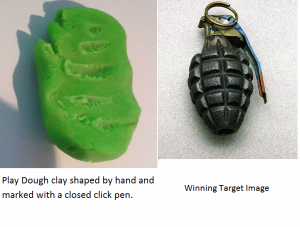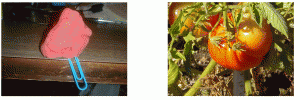Guest post by Mike Rogalski
(And some recent clay examples from Scott!)
Most of us know that the term “Remote Viewing” was always a misnomer. Many still prefer to call it “Remote Sensing”. They would be correct in terms of the purest of scientific descriptions. All of the sensory abilities are still used in S-2, but the aspect of touch and feel got side-tracked somewhere down the line. It was used in Stargate and Grill Flame as soon as they were into taking things from subjective to objective.
The use  of clay for describing targets had a lot of prominence for its ability to assemble a whole environment from multiple viewers on one 4 x 8 sheet of plywood. I don’t have the whole history of it, but knowing how irritating the whole idea was to conventional Pentagon brass, I assume that the projects took up a lot of space, and began to look like a day-care center. 🙂
of clay for describing targets had a lot of prominence for its ability to assemble a whole environment from multiple viewers on one 4 x 8 sheet of plywood. I don’t have the whole history of it, but knowing how irritating the whole idea was to conventional Pentagon brass, I assume that the projects took up a lot of space, and began to look like a day-care center. 🙂
Despite the problems encountered, clay development of targets was and still is, a significant part of target development for a LOT of people. We know that there were efforts to determine optimum skill sets in individual remote viewers so they could be counted on for highest accuracy in those aspects. When th ey eliminated clay, there was an elimination of useful information from people with those tactile skills. It never seemed to make a comeback in conventional teaching, but if you look at the original CRV descriptions by Paul Smith, the skill was included in the final documents.
ey eliminated clay, there was an elimination of useful information from people with those tactile skills. It never seemed to make a comeback in conventional teaching, but if you look at the original CRV descriptions by Paul Smith, the skill was included in the final documents.
We have placed the skill set in after the S-5 emanation page, as it was placed in the original CRV. At that point, you would take a ball of Playdoh, and list a quality from elsewhere needing to be “shaped” on the S-6 Dimensional category.
The page contains places for all S-2 sensories, but my experience so far has been that the only sensories I care to elaborate on is Dimensionals. The first thing we do is write down the word next to the category “D” for dimensional and then proceed to shape the clay to that first initial description. It looks something like this:
S-6
S——-
D———(enter your initial dimensional here)—-(enter conclusion from clay here)
A/I ——-
etc.
The mindset for taking it beyond this point is similar to the other stages, except it is mechanical movement. You begin to slightly reshape the clay from where it was, to different configurations, such as stretching, bending, compressing, indenting—any modification you feel is relevant to its development. You allow your fingers to do the work. The more you allow it to do what it needs to do to improve, certain aspects of its development will come to you. Tools can be used to complete an impression, but don’t use it to consciously establish what left-brain wants.
Go with the impression you receive from the clay, and flesh it out back into the clay.
Once, when I  was playing with a log-shaped piece of rather dry clay, the brittleness caused my torsioning of the bar to make it break. Instantly, I concluded that the target (a wooden puzzle), came apart! I could feel that the uniqueness of this object was that it could come apart. There is a delicate balance of moving the shape into a significant revelation, vs. left-brain intention to force it into a predetermined outcome. All the same right brain rules apply, but in this case, your fingers meander over the clay and will tell you what it is going to do.
was playing with a log-shaped piece of rather dry clay, the brittleness caused my torsioning of the bar to make it break. Instantly, I concluded that the target (a wooden puzzle), came apart! I could feel that the uniqueness of this object was that it could come apart. There is a delicate balance of moving the shape into a significant revelation, vs. left-brain intention to force it into a predetermined outcome. All the same right brain rules apply, but in this case, your fingers meander over the clay and will tell you what it is going to do.
I had one student puzzle over it, then “give up” by making a ball out of it, and pushing her thumb into it. It resembled the boat of a Noah’s Ark, our target for that session. This can be crucial development, just prior to the Written Summary. As with the addition of additional stages of exposition, this step can add another 10% accuracy or more to your sessions if you are so inclined. How much it provides will depend on the complexity of the target.
You can do this for each of your dimensionals and get good coherence each time. Like the blank page, the clay begins with a blank form. Then, apply “Fiercely Focused Inattention” to the process, and you’ll get some impressive answers you hadn’t anticipated. Any words derived tend to have high value.
Through observatio n of people with an inclination toward sculpting, I have seen them consistently elicit accurate 3-dimensional descriptions of the target. This is a valuable addition to your bag of skills.
n of people with an inclination toward sculpting, I have seen them consistently elicit accurate 3-dimensional descriptions of the target. This is a valuable addition to your bag of skills.
Good luck!
